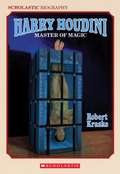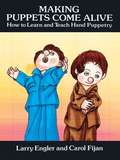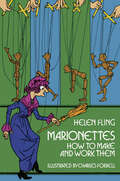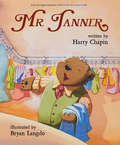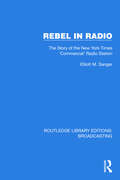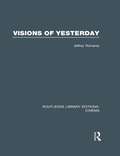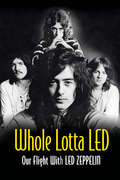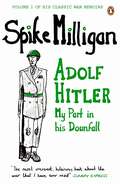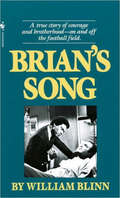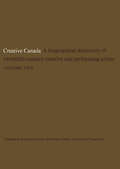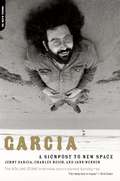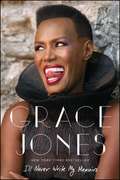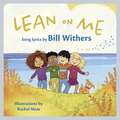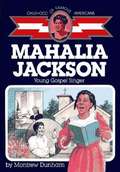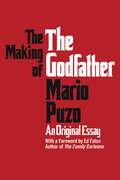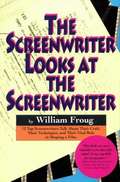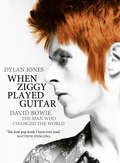- Table View
- List View
Harry Houdini: Master Of Magic
by Robert KraskeThis biography recounts the life of Harry Houdini from his boyhood through his years as an escape artist and master showman.
Kermit Schafer's Best of Bloopers
by Kermit SchaferSchafer has collected some of the funniest bloopers - misspeaking in a public forum - available and many of them from celebrities.
Making Puppets Come Alive: How to Learn and Teach Hand Puppetry
by Larry Engler Carol FijanUnlike other performing arts, puppetry is perhaps the only art form in which directing, acting, writing, designing, sculpture, and choreography are combined. In effect, the performer is creating an artistic entertainment that will appeal to audiences of all ages -- in homes, in theaters, and in classrooms.This lucid, easy-to-follow book was specifically conceived to teach beginners how to bring a hand puppet to life and how, with practice, to develop the skills needed to mount an amateur puppet show -- complete with staging, costumes, and special effects. Award-winning puppeteers Larry Engler and Carol Fijan provide ingenious finger, wrist, and arm exercises that are crucial for creating a full working range of puppet motions and emotions. They also cover the elements of good puppet theatrical technique: speech, voice use, and synchronization; stage deportment and interactions; improvisation, dramatic conflict, role characterization, and more.Every detail is clearly explained and beautifully illustrated with photographs, specific chapters being devoted to the use of props, puppet voices and movements, the construction of simple stages and lighting effects, and much more. A splendid addition to the literature on this subject, Making Puppets Come Alive is "the best book on hand puppetry we've seen." -- The Whole Kids Catalog.
Marilyn: A Biography
by Norman MailerBiography about the iconic figure and movie star, Marilyn Monroe.
Marionettes: How to Make and Work Them
by Helen FlingThis is the complete book of marionette craft -- from making heads and constructing bodies to stringing the marionettes on one- and two-hand controls, operating the marionettes, and putting on your own shows. Four books by Helen Fling have been brought together to make this volume. Their wealth of illustrations, tricks, helpful hints and solid, easy-to-follow advice will go far toward making your performances successful, enjoyable, and creative.In the first section, full details are given on making puppet and marionette heads -- creating them, molding them, casting them, making them out of plastic wood and pâpier-maché, painting them, and adding character details such as noses and wigs. The second section tells, in equal detail, how to make hands, feet, legs, arms, and bodies with a variety of methods for joining the parts together, taping, painting, finishing, and placing screw-eyes for mechanical perfection. The third section shows how to construct marionette controls, how to string your marionettes, and how to manipulate your controls for the movements, postures, gestures, and tricks. Costume and character details are also covered. By the end of this section both you and your characters should be ready to perform. The final section covers the details of marionette show production -- building a stage, lighting, scenery, sound effects, curtain-drops, and presentation. One complete play, with full details on stage props, marionettes, and background, is included. More than 400 helpful illustrations show every step of marionette craft from conception and construction to performance.Beginners will find this book to contain everything they need to know to construct marionettes and present their own shows. Puppeteers will find the chapter on head-making equally suited to their craft. Those who have some experience with marionettes will find the sections on tricks, alternate procedures, and professional methods to greatly increase their abilities to build marionettes and create a variety of new effects and successful marionette performances.
Mr. Tanner
by Harry ChapinMr. Tanner runs a dry cleaning shop in Dayton, Ohio, where he spends his days greeting his customers with his beautiful baritone voice. His friends and neighbors encourage him to sing professionally instead of cleaning clothes. He eventually takes a chance and travels to New York City to be heard by a concert agent and critics, only to find they weren't hearing what he was feeling. The song Mr. Tanner was released in 1973 off Harry Chapin's Short Stories album. The song was inspired by a mediocre review about a baritone singer in The New York Times. A portion of the proceeds from the sale of this book will go to help support WhyHunger, a charity championed by Harry Chapin himself.
Pennington's Heir (Pennington #3)
by K. M. PeytonGetting out of prison was like being born again, said Patrick Pennington. His adoring girl friend, seventeen-year-old Ruth Hollis, was waiting for him. Professor Hampton, Pat's piano teacher, had waited, too, for his impetuous star pupil to get out and get back to his music again. Now it looked like a sure, straight road to success, if Pat could just keep himself out of trouble and stick with his studies. But trouble and Pat Pennington have an affinity for each other. When Ruth tells him she is going to have his baby, Pat must face a new kind of problem--one that threatens both his personal happiness and his future as a concert pianist. Patrick Pennington, the rebellious and talented anti-hero of Pennington's Last Term and The Beethoven Medal, doesn't settle easily into the role of husband, father, and breadwinner. With humor, compassion, and deep insight, K. M. Peyton portrays a very young, very loving couple's rocky first year of marriage.
Rebel in Radio: The Story of the New York Times 'Commercial' Radio Station (Routledge Library Editions: Broadcasting #30)
by Elliott M. SangerRebel in Radio (1973) looks at the story of WQXR, the rebel New York commercial radio station. It examines WQXR’s place in broadcasting history, and how, at a time when American commercial radio had become but a pawn of the advertising industry, it showed that a radio station could be competitive and still maintain high programme and advertising standards.
Theatre Shoes
by Noel StreatfeildWhen their father is captured during the war, three children come to London to live with their grandmother and join their talented theatrical family in a school for stage training.
Visions of Yesterday (Routledge Library Editions: Cinema)
by Jeffrey RichardsFilm is an important source of social history, as well as having been a popular art form from the early twentieth century. This study shows how a society, consciously or unconsciously, is mirrored in its cinema. It considers the role of the cinema in dramatizing popular beliefs and myths, and takes three case studies – American populism, British imperialism, German Nazism – to explain how a nation’s pressures, tensions and hopes come through in its films. Examining the American cinema is accomplished by analysing the careers of three great directors, John Ford, Frank Capra and Leo McCarey, while the British and German cinemas are studied by theme. The analysis of the British Empire as seen in film broke exciting new ground with a pioneering account of ‘the cinema of Empire’ when it was first published in 1973. With full filmographies and a carefully selected bibliography it is an outstanding work of reference and its lively approach makes it a delight to read. Reviews of the original edition: ‘A work of considerable force and considerable wit.’ – Clive James, Observer ‘…a work that is original, mentally stimulating and most pleasurable to read.’ – Focus on Film
Whole Lotta Led: Our Flight With Led Zeppelin
by Ralph Hulett Prochnicky JerryIn September 1968, four English lads gathered together for the first time in a small, stuffy London rehearsal room in a basement filled with wall-to-wall amplifiers. It was their first big tryout as musicians, and each of them was nervous. Would they come together as a band? Or would they crash and burn, becoming nothing but a rock footnote? Then the room exploded, with wailing chords, howling vocals, and a locked-tight rhythm section-a sonic assault of heretofore unknown power. Here for the first time was Led Zeppelin: the screaming rock guitar of Jimmy Page, the scorching blues vocals of Robert Plant, the driving jazz bass of John Paul Jones, and the power drumming of John Bonham. The session was amazing, electrifying, and stunning. The Zepp had arrived. There was no turning back. And rock entertainment would never be the same again. Told by the band, the musicians, the groupies, and the fans themselves, this chronicle of one of rock's greatest and most innovative bands comes alive with the hiss of turntables, the sweat of the crowd at the Fillmore East, the hustle and bustle of backstage life, and the electricity of small clubs where rock history was about to be made. It's a story about a band's influence on two impressionable guys, and the countless others who came to get the Led out and stayed to become part of rock 'n' roll legend. With exclusive and rare photos
Adolf Hitler: My Part in his Downfall (Spike Milligan War Memoirs)
by Spike MilliganVolume one of Spike Milligan's legendary memoirs is a hilarious, subversive first-hand account of WW2'The most irreverent, hilarious book about the war that I have ever read' Sunday Express'Close in stature to Lewis Carroll and Edward Lear in his command of the profound art of nonsense' Guardian______________'At Victoria station the R.T.O. gave me a travel warrant, a white feather and a picture of Hitler marked "This is your enemy". I searched every compartment, but he wasn't on the train . . .' In this, the first of Spike Milligan's uproarious recollections of life in the army, our hero takes us from the outbreak of war in 1939 ('it must have been something we said'), through his attempts to avoid enlistment ('time for my appendicitis, I thought') and his gunner training in Bexhill ('There was one drawback. No ammunition') to the landing at Algiers in 1943 ('I closed my eyes and faced the sun. I fell down a hatchway'). Filled with bathos, pathos and gales of ribald laughter, this is a barely sane helping of military goonery and superlative Milliganese.______________ 'That absolutely glorious way of looking at things differently. A great man' Stephen Fry'Milligan is the Great God to all of us' John Cleese 'The Godfather of Alternative Comedy' Eddie Izzard 'Manifestly a genius, a comic surrealist genius and had no equal' Terry Wogan 'A totally original comedy writer' Michael Palin
Brian's Song
by William BlinnTwo men. One named Gale Sayers, the other Brian Piccolo. They came from different parts of the country. They competed fiercely for the same job. One liked to talk; the other was shy. One was white; the other black. This is the story of how they came to know each other, fight each other, and help each other
The Church Cantatas of J. S. Bach
by Alec RobertsonFor nearly every Sunday from 1723 to 1728, J S Bach composed and his young orphan boy-students performed, a half-hour cantata in the Lutheran church services of the Saint Thomas Church in Leipzig, Germany. A cantata usually began with a chorus, contained recitatives (narrative) and arias (meditations) and closed with a hymn (chorale). Bach's cantatas contain more than 1500 movements, filling 67 compact discs in today's recordings. They contain dozens of magnificent choruses and hundreds of deeply-felt and spectacular arias and chorales. Alec Robertson analyzes 173 of Bach's roughly 210 extant cantatas. He organizes them according to the Lutheran church year, starting with Advent and ending with the Reformation Festival of October 30. He introduces each Sunday and feast day with the Biblical citations which were usually the basis for the cantatas. He discusses each movement, even listing the instrumentation. Bach's cantatas are at the pinnacle of western classical music. Not only do they give spiritual nourishment to Christians and non-Christians but they are studied the world over by amateur and professional musicians for their penetrating pictorialization, harmonizations, counterpoint and beautiful melodies. They contain great choruses, arias for all types of singers, plus some duets and trios. Whether you are an amateur or serious musician, this book will help you to understand and appreciate these works. Cantatas not discussed in this book are those intended for special occasions such as weddings, funerals, birthdays of prominent persons, civic events such as town council inaugurations, those with secular themes and those originally included in the Bach canon but which modern scholarship has determined not to have been his compositions (de-established). Accordingly, the following cantatas are not discussed: 11, 15 (deest.), 29, 50, 53 (deest), 54, 71, 97, 106, 117, 118, 119, 120, 131, 141 (deest.), 142 (deest.), 150, 160 (deest.), 189 (deest.), 191, 192, 193, 195, 196, 197, 198 and 200-215. In this braille file, German words are shown using Braille grade 2 English contractions. If you download the DAISY file, you will get the German words uncontracted. Note: an excellent internet source for all things Bach cantatas is http://bach-cantatas.com/ .
Creative Canada: A Biographical Dictionary of Twentieth-century Creative and Performing Artists (Volume #2)
by Reference Division, McPherson Library, University of VictoriaDid he ever play Hamlet? Has she worked in television? What was the title of his first novel? Under whom did she study? How many children has he? Answers to such questions about contemporary Canadian artists have often been difficult, even impossible, to find. This series has been created to provide the answers; it covers creative and performing artists who have contributed as individuals to the culture of Canada in the twentieth century. Each volume in the series presents a cross-section of many different kinds of artists: authors of imaginative works, artists and sculptors, musicians (performers, composers, conductors, and directors), and performing artists in ballet, modern dance, radio, theatre, television, and motion pictures; directors, designers, and producers in theatre, cinema, radio, television, and the dance; choreographers and, for cinema, cartoonists and animators. Within each category of art is included a selection of those who have achieved national and international recognition; those who have been recognized locally, and some, now deceased, who markedly influenced their contemporaries locally, nationally, or internationally. This is not a critical compilation; rather it is an objective and factual reference work for those interested in contemporary Canadian culture. Information was collected by painstaking research in a wide variety of sources, and wherever possible it has been verified by the artist to make each entry as accurate and comprehensive as possible.
The Fred Astaire and Ginger Rogers Book
by Arlene CroceA book about the famous dancing duo, Fred Astaire and Ginger Rogers.
Garcia: A Signpost to New Space
by Jann Wenner Jerry Garcia Charles ReichJerry Garcia (1942-1995) is an American icon. The guitarist and de facto leader of the Grateful Dead was a gregarious talker, keenly engaged with the new world exploding around him. In 1972, Garcia was visited by Charles Reich, a Yale law professor, and Jann Wenner, the founder of Rolling Stone. Garcia was just thirty-one years old but already viewed--to his lasting dismay--as a social avatar for the new sensibility sweeping the land, an anarchist streak with a populist undercurrent that had roots in Ken Kesey's pranksters, the writers of the Beat Generation, and the libertine tradition of the American transcendentalists. In this interview, Garcia reveals how he is a combination of these and other influences, a high-school dropout and autodidact blessed with a gift for eloquent turns of phrase and a refreshing directness. He speaks of the saga of the Grateful Dead and his hoodlum youth growing up in San Francisco's Mission district. He delves into fascinating discourses on the music that shaped his own playing and writing, and freely discusses his use of drugs and explains why he felt it was important to stay high. Like the Grateful Dead's best music, Garcia: A Signpost to New Space is familiar, friendly, and inviting.
Hollywood in the Sixties
by John BaxterHollywood in the 1960s is not truly Hollywood, but a factory whose product lacks the magic of earlier decades. Perhaps some magic will accrue over the years, but once we are aware of its mechanics will the alchemy continue to work? Like the cartoon characters, we remain suspended in the air only as long as we are unaware of being so; as soon as we look down, we fall.
I'll Never Write My Memoirs
by Grace Jones Paul MorleyIconic music and film legend Grace Jones gives an in-depth account of her stellar career, professional and personal life, and the signature look that catapulted her into the stardom stratosphere. Grace Jones, a veritable “triple-threat” as acclaimed actress, singer, and model, has dominated the entertainment industry since her emergence as a model in New York City in 1968. Quickly discovered for her obvious talent and cutting-edge style, Grace signed her first record deal in 1977 and became one of the more unforgettable characters to emerge from the Studio 54 disco scene, releasing the all-time favorite hits, “Pull Up to the Bumper,” “Slave to the Rhythm,” and “I’m Not Perfect (But I’m Perfect for You). ” And with her sexually charged, outrageous live shows in the New York City nightclub circuit, Grace soon earned the title of “Queen of the Gay Discos. ” But with the dawn of the ’80s came a massive anti-disco movement across the US, leading Grace to focus on experimental-based work and put her two-and-a-half-octave voice to good use. It was also around this time that she changed her look to suit the times with a detached, androgynous image. In this first-ever memoir, Grace gives an exclusive look into the transformation to her signature style and discusses how she expanded her musical triumph to success in the acting world, beginning in the 1984 fantasy-action film Conan the Destroyer alongside Arnold Schwarzenegger, then the James Bond movie A View to a Kill, and later in Eddie Murphy’s Boomerang. Featuring sixteen pages of stunning full-color photographs, Miss Grace Jones takes us on a journey from Grace’s religious upbringing in Jamaica to her heyday in Paris and New York in the ’70s and ’80s, all the way to present-day London, in what promises to be a no holds barred tell-all for the ages.
Lean on Me: A Children's Picture Book (LyricPop #0)
by Bill WithersBill Withers's classic anthem to friendship lives on in this moving children's picture book adaptation. Lean on me When you’re not strong And I’ll be your friend I’ll help you carry on . . . Lean on Me is an endearing children's picture book that beautifully demonstrates the power of friendship, based on Bill Withers's classic song of the same name. “Lean on Me” appeared on Withers's 1972 album Still Bill. The song reached #1 on the Billboard Hot 100 chart and ranked #208 on Rolling Stone's "500 Greatest Songs of All Time" list. With Withers's lyrics and illustrations by Rachel Moss, this picture book follows four close friends through the stages of their childhood, from elementary school until their high school graduation. Withers’s classic and loving refrain serenades them as they lean arm-in-arm into adulthood.
Mahalia Jackson: Young Gospel Singer (Childhood of Famous Americans Series)
by Montrew DunhamBiography of the great gospel singer, Mahalia Jackson.
The Making of the Godfather
by Mario PuzoIn this entertaining and insightful essay, Mario Puzo chronicles his rise from struggling writer to overnight success after the publication of The Godfather. With equal parts cynicism and humor, Puzo recounts the book deal and his experiences in Hollywood while writing the screenplay for the movie. Francis Ford Coppola, Robert Evans, Peter Bart, Marlon Brando, and Al Pacino all make appearances-as does Frank Sinatra, in his famous and disastrous encounter with Puzo. First published in 1972, the essay is now available as an ebook for the first time. A must-have for every Godfather fan! Featuring a foreword by Ed Falco, author of The Family Corleone.
Parents' and Teachers' Guide to Music Education
by Roberta MarkelPractical advice on choosing, selecting and buying an instrument, finding a good teacher, learning the language of music, singing, practicing, and careers in music
The Screenwriter Looks at the Screenwriter
by William FrougTwelve of Hollywood's top screenwriters discuss their craft and their lives, including: Johnson 'Grapes of Wrath', Diamond 'Some Like It Hot', Henry 'The Graduate', and Lardner 'M*A*S*H'.
When Ziggy Played Guitar: David Bowie, The Man Who Changed The World
by Dylan JonesAnd then there was David Bowie, the uber-freak with the mismatched pupils, the low-tech space face from the planet Sparkle. This was Bowie's third appearance on TOTP but this was the one that properly resonated with its audience, the one that would go on to cause a seismic shift in the Zeitgeist. This is the performance that turned Bowie into a star, embedding his Ziggy Stardust persona into the nation's consciousness. With a tall, flame-orange cockade quiff (stolen from a Kansai Yamamoto model on the cover of Honey), lavishly applied make-up, white nail polish, and wearing a multi-coloured jump-suit that looked as though it were made from fluorescent fish skin (chosen by Ziggy co-shaper, the designer Freddie Buretti), and carrying a brand spanking new, blue acoustic guitar, a bone-thin Bowie appeared not so much as a pop singer, but rather as some sort of benevolent alien, a concept helped along by the provocative appearance of his guitarist, the chicken-headed Mick Ronson, with both of them unapologetically sporting knee-length patent leather wrestler's boots (Bowie's were red). 'Most people are scared of colour,' Bowie said later. 'Their lives are built up in shades of grey. It doesn't matter how straight the style is, make it brightly coloured material and everyone starts acting weird.' Suddenly Bowie - a man called alias - had the world at his nail-varnished fingertips, and in no time at all he would be the biggest star in the world.
